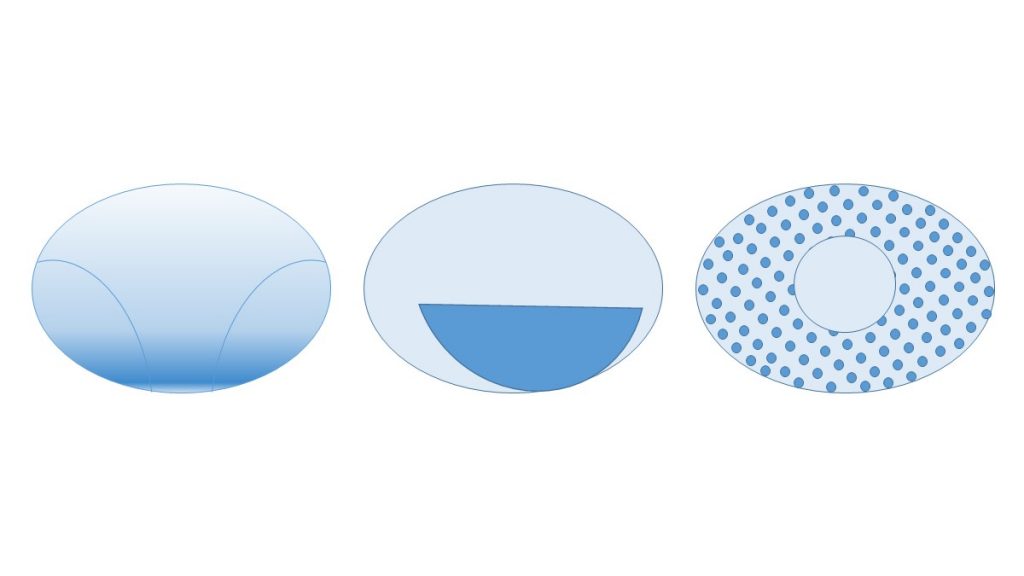Podcast summary:
Are progressive addition lenses and bifocals created equal for myopia control? How should we pick which lens type to prescribe, and what's on the horizon for our non-contact lens wearing young myopes?
- Progressive addition lens (PAL) studies for myopia control show negligible results when single adds are applied to all children, however when applied to children with esophoria and accommodative lag, the results become more impressive at 30-40% efficacy and start to approach that of contact lens studies.1, 2
- One well designed bifocal study found a 40-55% efficacy for a +2.00 Add E-seg bifocal with 2 base-in prism incorporated. Does this make the bifocal or the prism the magic sauce? Perhaps, or maybe it was more to do with the excellent study design and ensuring binocular vision was balanced in all children, as the base-in prism helped exophores maintain better binocularity with the add.3
- There is conjecture about PAL or bifocal spectacles having any useful effects for myopia control4, 5 just the same as there is conjecture about peripheral refraction being a factor in myopia development and progression.6, 7 For the individual patient, there could be one primary driver to myopia development and progression – genetics, environment, peripheral refraction, accommodation – or it could be a combination. This is what makes myopia such a fascinating area of research and clinical practice.
- In practice we aren’t likely to apply a single add to all children – we will prescribe it based on their presentation. Their measured accommodative lag, esophoria, or both will factor into the prescribing decision, and individualising the add could be responsible for the difference between what’s measured in research and what we observe in practice.
- Once the add has been determined, selecting a PAL or bifocal may come down more to the patient than to efficacy. The full power of a bifocal add in downgaze is appealing, provided the frame doesn’t slip down, but cosmesis isn’t a winner. Adaptation may be harder in a PALs, but regardless of frame position the child will be using some of the add, cosmesis is better, and shorter corridor designs can be employed.
- Children prescribed atropine should also be monitored for needing an add – while research has described a minimal effect on amplitude of accommodation,8 we are yet to understand how atropine affects more detailed measures of binocular vision.
- New spectacle lens technology for myopia control is on the horizon – the award winning Defocus Incorporated Multiple Segments (DIMS) spectacle lens, developed at Hong Kong Polytechnic University. It looks like a single vision lens but could work more like a contact lens because of its innovative design, and has shown contact-lens-level results in initial studies.9
Further reading includes four reasons why binocular vision matters in myopia control and expanding your clinical skills in binocular vision. Thanks for listening.

About Kate
Dr Kate Gifford is a clinical optometrist, researcher, peer educator and professional leader from Brisbane, Australia, and a co-founder of Myopia Profile.
References
- Gwiazda J, Hyman L, Hussein M et al. A randomized clinical trial of progressive addition lenses versus single vision lenses on the progression of myopia in children. Invest Ophthalmol Vis Sci. 2003;44:1492-500. (link)
- Yang Z, Lan W, Ge J et al. The effectiveness of progressive addition lenses on the progression of myopia in Chinese children. Ophthal Physiol Opt. 2009;29:41-8. (link)
- Cheng D, Schmid KL, Woo GC, Drobe B. Randomized Trial of Effect of Bifocal and Prismatic Bifocal Spectacles on Myopic Progression: Two-Year Results. Arch Ophthalmol. 2010;128:12-9. (link)
- Cheng D, Woo GC, Schmid KL. Bifocal lens control of myopic progression in children. Clin Exp Optom. 2011;94:24-32. (link)
- Berntsen DA, Mutti DO, Zadnik K. Study of Theories about Myopia Progression (STAMP) Design and Baseline Data. Optom Vis Sci. 2010;87:823-32. (link)
- Smith ELI. Prentice Award Lecture 2010: A Case for Peripheral Optical Treatment Strategies for Myopia. Optom Vis Sci. 2011;88:1029-44. (link)
- Atchison DA, Li SM, Li H et al. Relative Peripheral Hyperopia Does Not Predict Development and Progression of Myopia in Children. Invest Ophthalmol Vis Sci. 2015;56:6162-70. (link)
- Chia A, Lu QS, Tan D. Five-Year Clinical Trial on Atropine for the Treatment of Myopia 2: Myopia Control with Atropine 0.01% Eyedrops. Ophthalmology. 2016;123:391-9. (link)
- Lam CS-Y, Tang WC, Lee RP, Chun RK, To CH. Myopia control with multi-segment myopic defocus (MSMD) spectacle lens: a randomised clinical trial. Ophthal Physiol Opt. 2017;37:International Myopia Conference O017. (link)











